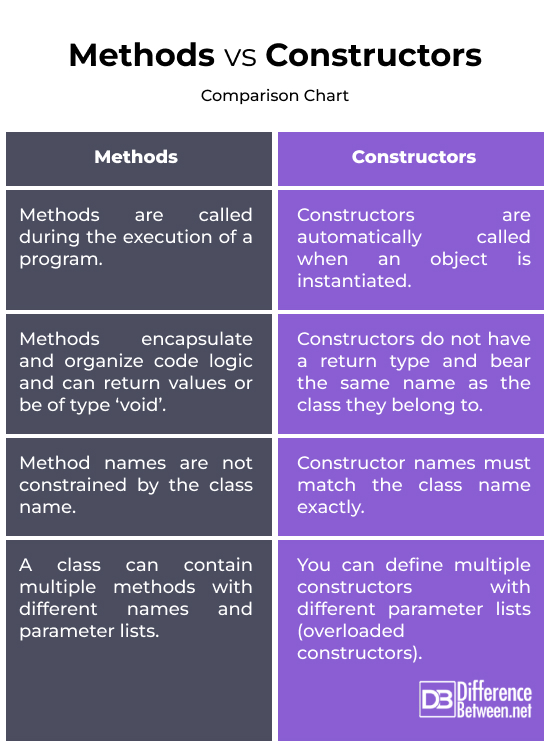Difference Between a Method and a Constructor in Java
In Java, methods and constructors are like the dynamic duo of building and executing code. They are the tools that enable us to create and manipulate objects. Methods are the workhorses of Java, the pieces of code that perform specific tasks. Constructors are quite similar to methods, but there are subtle differences between the two.
Well, methods allow us to break down our code into manageable, reusable chunks. Constructors ensure that our objects start with a clean slate, making sure they’re properly set up for the tasks ahead. In this article, we’ll talk about the fundamental differences between methods and constructors.

What is a Method in Java?
Methods are the functions or behaviors described within a class. They define what actions an object of that class can perform. Methods are the pieces of code that perform specific tasks. They encapsulate the logic and functionality that make our programs do what we want them to do. Whether it’s crunching numbers, displaying text, or processing data, methods are our go-to functions to get the job done.
Methods are defined within classes and can be invoked to execute a particular operation. They make your code modular, reusable, and organized.

What is a Constructor in Java?
Constructors are a special type of method within a class. Their primary job is to initialize an object when it is created. They set the stage for objects, defining their initial state and getting them ready for action. Constructors have the same name as the class they belong to, and they don’t have a return type.
You can use constructors to initialize the attributes or properties of an object when it’s created. This ensures that the object starts with a known and valid state.
Difference between a Method and a Constructor in Java
Invocation
Methods in Java are used to define behaviors and actions that objects can perform. They are invoked by name and can be called multiple times during the program’s execution. Constructors, on the other hand, are used exclusively for initializing objects when they are created. They are automatically called when an object is instantiated and set up the initial state of the object.
Return Type
Methods can have a return type, which specifies the type of value they produce. This can be a primitive data type, an object, or ‘void’ if the method doesn’t return anything. Constructors do not have a return type declaration. They focus on setting up the object’s initial state and do not produce values like methods.
Naming Convention
Method names are not constrained by the class name. They can have unique names within the class and are typically named to describe the action they perform. Constructor names must match the class name exactly, which differentiates them from regular methods. This naming convention helps Java identify and use constructors during object creation.
Multiple Definitions
A class can contain multiple methods with different names and parameter lists, allowing for a variety of behaviors and actions to be defined within the class. In a class, you can define multiple constructors with different parameter lists (overloaded constructors). These allow objects to be created with different initializations, accommodating various scenarios, but constructors share the same name as the class.
Methods vs. Constructors: Comparison Chart

Summary
To sum it all up, methods are designed to provide reusable and specific behaviors for objects, while constructors are exclusively used for initializing object instances. Methods can have return types, use unique names, and be invoked multiple times, whereas constructors lack a return type, share the class name, and are called automatically during object creation to set up initial states.
FAQs
What is the difference between the constructor and the main method?
A constructor is a special method in Java used for initializing objects when they are created. Constructors have the same name as the class and do not have a return type.
The ‘main’ method, on the other hand, is the entry point of a Java program. It is a standard method that the Java Virtual Machine (JVM) calls to start the execution of a Java application.
Is a Constructor a method in Java?
Yes, a constructor is a method in Java, but it’s a special type of method used specifically for object initialization. Constructors are defined within classes and serve to set the initial state of objects.
What is the difference between a method and a constructor in Java w3schools?
In Java, methods are used for defining behaviors, whereas constructors initialize objects.
What is the difference between constructor and method overloading in Java?
Constructor overloading involves defining multiple constructors in a class with different parameter lists. This allows you to create objects with different initializations. Method overloading, on the other hand, involves defining multiple methods with the same name in a class but with different parameter lists.
Is a constructor just a method?
Constructors are special methods dedicated to object initialization, and they have distinct rules and behaviors, such as having the same name as the class and not having a return type.
Why is a constructor a method?
Constructors are called methods because they are defined within a class and share similarities with methods in terms of syntax and structure. However, they serve the unique purpose of initializing objects, ensuring that objects start in a well-defined state when created.
- Difference Between Caucus and Primary - June 18, 2024
- Difference Between PPO and POS - May 30, 2024
- Difference Between RFID and NFC - May 28, 2024
Search DifferenceBetween.net :
Leave a Response
References :
[0]Niemeyer, Patrick, and Jonathan Knudsen. Learning Java. “O’Reilly Media, Inc.,” 2002.
[1]Bloch, Joshua. Effective Java (2nd Edition). Pearson Education India, 2016.
[2]Gosling, James, et al. The Java Language Specification. Addison-Wesley, 2014.
[3]Image credit: https://www.canva.com/photos/MADV-btY8IA-java-programming-concept-virtual-machine-on-server-room-background-/
[4]Image credit: https://www.canva.com/photos/MAEEfqmEc5g-java/
